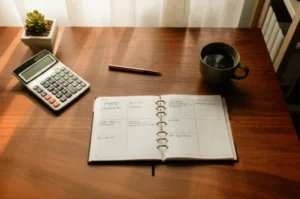Why 6 Months Just Hits Different
Let’s just say it: The idea of saving up a chunky house down payment in six months sounds a little wild, right? I mean, most of us have a hard time going one week without caving for that overpriced coffee or skipping delivery “just this once.” But six months—180 days—of focus? It’s not a magic trick. It’s a sprint…and honestly, it’s kind of exciting.
Maybe you’re here because scrolling Zillow at midnight turned dangerous. Or because your rent went up again…and you’re tired of paying someone else’s mortgage. Me too. I’ve got thoughts, mishaps, and a few accidental wins when it comes to stashing cash fast. So grab your notepad—or your favorite budgeting app—and let’s talk about how to save for a house down payment in 6 months. Messy, real, and 100% doable, even if you’ve tried (and failed) before.
What’s Your “Why” and Your Number?
Wait, How Much Should You Even Save?
Okay, first up: Let’s ground this in reality. Lenders usually want anywhere from 3% to 20% down. The average these days? Somewhere between 5% and 10% will get you past most bank doors—and possibly help you avoid some annoying add-ons like private mortgage insurance (PMI) according to real-world down payment guides.
Here’s where it gets interesting. Let’s say you’re eyeing a $350,000 house. A 5% down payment? That’s $17,500. Divide that by six months—yeah, that’s $2,917 each month. It’s a number that’ll make you sweat a little, but it’s not impossible if you know where your money goes and hustle hard (or get creative).
And if you’re already starting with, say, $8,000 tucked away, suddenly the monthly grind isn’t quite so painful. Have you ever tracked your savings progress with one of those thermometer charts? It’s weirdly motivating to color in another section, trust me.
How Loan Types Stack Up
| Loan Type | Min Down Payment | Notes |
|---|---|---|
| Conventional Loan | 3% (20% to skip PMI) | Lowest at 3%, but 20% avoids extra insurance |
| FHA Loan | 3.5% | Popular with first-timers, easier credit |
| VA/USDA Loans | 0% | Special eligibility, low entry point |
P.S. If you find six months just isn’t enough, there’s no shame in a longer game plan—browse tips from how to save for a house in 5 years and adjust with zero guilt.
Buckle Up: Budget Like Tomorrow Depends On It
Where Does Your Money Even Go?
Here’s the “aha” moment for a lot of us: We think we know our spending, until we actually track it. I thought most of my costs were “essentials,” but—surprise!—a bunch of my “essentials” were mood-based Amazon buys and $15 salad splurges. So go detective mode and dig through the last 2-3 months of your bank statements.
Some folks swear by tracking apps that categorize everything for you. Others love the old-school envelope system—physical cash only, per category. The real point? Find your leaks. Even $4 streaming subscriptions you never use count (guilty). If you’re serious about making a six-month push, there’s no such thing as an expense “too small” to cut.
One time I did a “no-spend” month. It was awkward, boring, and slightly liberating. At the end? I had nearly an extra $500. Imagine doing that—or something similar—every single month for half a year.
Embrace the Zero Dollar Transfer
Once you see where you can trim, automate your savings. Seriously, set up an auto-transfer on payday. Out of sight, out of mind. If you can route it straight into a high-yield savings account? Even better. I used to skip this step… guess how much I saved? Not nearly enough. The friction of moving money manually hurts your momentum—and makes late-night pizza too easy.
If you’re overwhelmed and wondering, “Where should I keep my money while saving for a house?”—look for the highest yield that still lets you access the cash quickly if your timeline runs off-course. For more details, peek at where should I keep my money while saving for a house to maximize returns without risking your goal.
Cut Ruthlessly, But Keep Your Joy
Frugal Wins (That Don’t Feel Miserable)
Here’s the part everyone dreads: cutting back. People hear “frugal” and picture living off beans in a cold, dark room. Reality? It’s a lot less dramatic, and sometimes… kind of fun. Think of it as a challenge. Every dollar you save gets you closer to your doorbell, not your landlord’s.
- Shop insurance deals—bundle car and renters for a surprise discount.
- Downsize streaming, swap to ad-supported for six months. (I cut $40/month just by canceling two I barely used.)
- Renegotiate phone/internet. Companies will haggle if you threaten to walk.
- Batch cook—plan five “boring” but cheap meals, then let yourself have one fun food night a week.
- Borrow or rent stuff you rarely use, instead of owning everything (I did this with power tools once—zero regrets!)
I know one single mom who asked her kids to help choose which takeout meals they’d switch to homemade versions; they even started a savings jar labeled “Our New House Fund.” Cheesy, but they hit their goal with weeks to spare. The bottom line: It doesn’t have to feel like punishment if you pick your “sacrifices” wisely.
Check How Fast Small Cuts Add Up
| Monthly Expense | Old Cost | New Cost | Pocketed Savings |
|---|---|---|---|
| Takeout (weekly) | $180 | $60 | $120 |
| Streaming | $60 | $20 | $40 |
| Car Ins. (re-shopped) | $120 | $90 | $30 |
Stack Your Income: The Overlooked Superpower
Side Hustle—Or Just Hustle What You Have?
So, you’ve cut expenses to the bone, automated everything…and the numbers still aren’t where you want? Time to look at the other half of the puzzle: bringing in more. I know, “start a side hustle” sounds like advice from people who always have energy. But small, sanity-saving gigs (babysitting, Uber, selling stuff online) can mean several hundred dollars every month.
Maybe your boss won’t hand you a raise right now, but can you ask for more hours? Or volunteer for a project that pays out a bonus? Every extra $100 feeds the beast—er, house fund. Don’t overlook surprise windfalls, like refunds, bonuses, or even birthday money. Shove it straight into your down payment account before you have time to reconsider.
If you’re thinking about how to save money for a house on a low income, don’t get discouraged. It’s 100% possible. I’ve seen people with tight budgets who took on a part-time weekend job just for six months, flipping the script on their entire financial future. If you need a little inspiration, there’s a goldmine of creative hacks over at how to save money for a house on a low income—I sent this to my sister when she was feeling stuck, and it was the nudge she needed.
Still Renting? The Balancing Act
How to Save for a House While Renting
Rent eats a huge chunk, we know. That doesn’t mean you’re disqualified from the fast-track club. It just means your game plan matters more. If moving home with parents isn’t an option, could you split costs with a roommate? Downsize your space for a while? Or, more realistically, could you move to a slightly cheaper apartment for the next lease term? It might save you a few hundred bucks a month, which, when redirected, becomes rocket fuel for your down payment. More on this at how to save for a house while renting.
My friend Jia did this—she moved into a quirky (read: old) duplex with a buddy for a year. Gave up granite countertops but gained an extra $400/month for her house fund. Now she sends me photos of her new backyard garden. Totally worth it.
Don’t Sleep on Down Payment Assistance
There’s Free Money in the World
You know those state and local programs you always hear about but never actually look into? Yeah—those can bridge the gap if you’re almost at your six-month goal but not quite there. Some offer small grants, others low-interest loans, or even help covering closing costs. A few states target first-time buyers hard, so make sure to check your eligibility early in the process, not after you’re burned out.
Honestly, I ignored this for too long, thinking “I won’t qualify.” When I actually checked, turns out I could’ve saved another $2,000. Facepalm. Don’t be me.
For folks who want an even deeper dive into stretches like how to save for a house in 2 years (because, hey, six months is tight!), there are tools and breakdowns out there—even stories about families who used three or more local programs to get across the finish line.
One Last Thing: Celebrate Milestones (Seriously)
It’s a Marathon—in Sprints
Six months is short, but it’s not always smooth. Break your big hairy goal into smaller chunks—every 20% of the way there, give yourself a non-money reward (park picnic, binge night, whatever feels fun but frugal). Saving for something big is hard…stacking little wins keeps you sane.
Ask yourself: What can you cut just for this window of time? Where can you squeeze more out of your budget, or your hustle? How satisfying would it be to look back, keys in hand, and think: “Huh, I actually did that.”
And hey, if you get through six months and need a breather? That’s fine too! Check out the longer game at how to save for a house in 5 years. A detour doesn’t mean the dream is dead.
Ready? Your Future Self Will Thank You.
Here’s the real talk: No plan is perfect. You’ll mess up, spend too much one weekend, maybe side-eye your down payment tracker and grumble. But you’ll also surprise yourself… finding extra money where you never looked, or watching your balance inch upward faster than you imagined.
So, whether you’re starting from zero or just want a little accountability, remember—the six-month clock is on your side, as long as you show up. Small tweaks add up. Today’s coffee, tomorrow’s closing day excitement. Check in, adjust, forgive, and keep going. Home is closer than you think—let’s make it happen. What will you cut or add first? I’m rooting for you.













